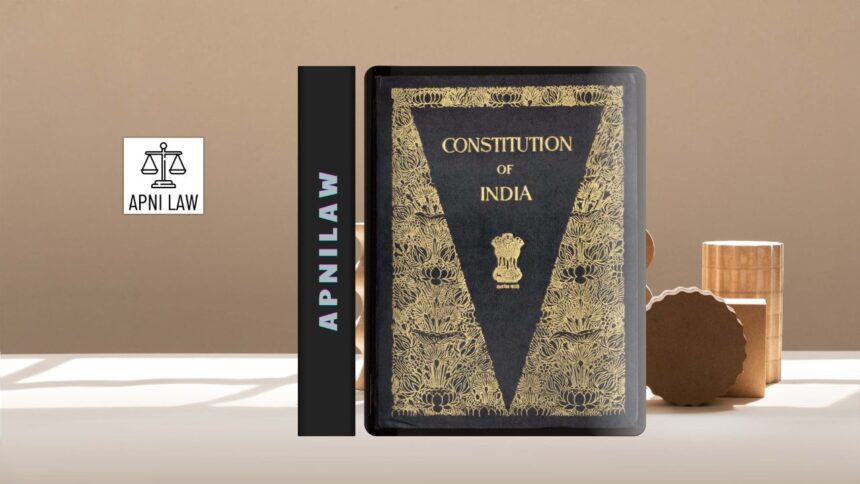Introduction
Articles 256 to 263 of the Indian Constitution define the administrative relations between the Centre and the States. These provisions regulate how executive powers are shared, coordinated, and controlled to ensure smooth governance. They also provide mechanisms for resolving disputes and fostering cooperation.
India’s federal system is unique because it is both centralized and flexible. While the States enjoy autonomy in their own spheres, the Union government retains supervisory authority to safeguard national unity and efficient administration. The administrative relations under these articles aim to balance these two objectives.
How Does the Centre Direct the States Under Articles 256 and 257?
Article 256 lays down a fundamental rule. It requires every State to ensure compliance with laws made by Parliament. It also empowers the Union to issue directions to States whenever necessary. This mechanism ensures that central laws are uniformly applied across the country. For example, when Parliament enacts laws on subjects like environment or education, States must implement them in their territories.
Article 257 reinforces this arrangement. It restricts State governments from exercising executive powers in a way that impedes Union functions. It also gives the Centre authority to issue directions in key areas such as railways, communication, and industries of national importance. The costs of compliance usually fall on the States, unless the President directs otherwise. This provision highlights the supremacy of Union interests in matters crucial for national development.
How Is Delegation of Functions Managed?
The Constitution recognizes the need for flexibility in administration. Article 258 empowers the President to entrust Union functions to States. This delegation can be conditional or unconditional, but it requires the consent of the concerned State. For instance, the Union may delegate customs enforcement or border security duties to State agencies for better efficiency.
Article 258A provides the reverse mechanism. A State legislature can entrust its executive functions to the Union with Parliament’s approval. This promotes cooperative federalism, especially for joint programs such as poverty alleviation schemes or rural health projects. By allowing mutual delegation, the Constitution ensures adaptability in governance.
What Do Articles 260 to 262 Provide for?
Article 260 extends India’s administrative reach beyond its borders. It permits the Union to perform executive functions in foreign territories, provided there is an agreement. This enables India to cooperate internationally in areas such as defense or trade administration.
Article 261 establishes the principle of administrative uniformity. It requires that laws, records, and judicial proceedings of both Union and State authorities be recognized throughout India. For example, a birth certificate issued in Kerala is valid in Maharashtra. This provision strengthens national integration by ensuring mutual recognition of administrative acts.
Article 262 addresses a sensitive issue, inter-State river water disputes. It allows Parliament to provide a mechanism for adjudication of such disputes. Once Parliament has legislated, the jurisdiction of courts is barred. The Inter-State Water Disputes Act of 1956 was enacted under this provision. This law has enabled the setting up of tribunals to resolve conflicts like the Cauvery water dispute between Karnataka and Tamil Nadu.
What Role Does Article 263 Play in Coordination?
Article 263 empowers the President to establish an Inter-State Council. This body promotes coordination between the Centre and States and among States themselves. It serves three functions: to discuss policies, to investigate disputes, and to make recommendations for better cooperation.
Although Article 263 does not make the Council mandatory, the Sarkaria Commission recommended its establishment to strengthen federal cooperation. Acting on this advice, the Inter-State Council was set up in 1990. It continues to function as a platform for dialogue on national issues like fiscal federalism, internal security, and social welfare programs.
How Do These Provisions Promote Cooperation?
Administrative relations are not limited to directions and delegation. They also rely on cooperative instruments. The Constitution allows for the creation of All-India Services under Article 312. Officers from these services work in both Union and State governments, ensuring a uniform standard of administration. The Indian Administrative Service and Indian Police Service are prime examples.
The Centre also uses financial tools to promote cooperation. Grants-in-aid under Article 275, centrally sponsored schemes, and special assistance packages incentivize States to align with national priorities. For example, programs like the National Health Mission and Swachh Bharat Abhiyan rely on joint funding and execution.
Emergency provisions also shape administrative relations. Article 355 places a duty on the Union to protect States against external aggression and internal disturbances. This allows the Centre to intervene when State machinery fails, thereby safeguarding national integrity.
Why Do Administrative Relations Favor the Centre?
The tilt toward central control in Articles 256 to 263 reflects the vision of the Constitution makers. India’s history of partition, linguistic diversity, and social inequalities required a strong central authority. Unlike in a confederation, the Indian Union is indestructible, and States derive their powers from the Constitution itself.
The Constituent Assembly believed that too much autonomy could threaten unity. By giving the Centre authority to issue directions and assume State functions when necessary, the Constitution ensured stability. This design has been tested during emergencies, insurgencies, and inter-State disputes, and it has often succeeded in maintaining order.
How Have Commissions and Courts Interpreted These Provisions?
Several commissions have studied Centre-State relations. The Sarkaria Commission emphasized cooperative federalism and recommended that directions under Article 256 should be used sparingly. It also highlighted the need for regular meetings of the Inter-State Council. The Punchhi Commission in 2010 suggested even greater consultation between the Union and States to reduce friction.
The judiciary has also clarified the scope of these provisions. In State of Rajasthan v. Union of India (1977), the Supreme Court held that the Union cannot give directions to States for political purposes. Courts have insisted that Union control should be exercised in good faith and only for constitutional objectives.
What Challenges Exist in Administrative Relations Today?
Despite constitutional safeguards, administrative relations face challenges. States often complain that the Centre issues excessive directions, undermining their autonomy. Disputes arise over centrally sponsored schemes where States bear financial burdens but have little say in policy design.
River water conflicts remain contentious, with tribunal awards often leading to political tensions. Similarly, the functioning of the Inter-State Council has been irregular, limiting its effectiveness. States also demand greater consultation in matters like national security laws and economic policies.
The growing role of technology and digital governance adds new dimensions. Coordination between Union and States is necessary for data sharing, cybersecurity, and nationwide programs like Aadhaar. These challenges call for updated mechanisms of cooperation.
How Do These Provisions Balance Autonomy and Unity?
Articles 256 to 263 show a careful balance between State autonomy and central control. While States retain executive authority within their territories, the Union ensures national uniformity through directions, delegation, and coordination. Mechanisms like the Inter-State Council encourage dialogue, while provisions for water disputes and emergency powers protect unity.
The system is not perfect, but it reflects a flexible design. It adapts to crises, fosters cooperation, and prevents conflicts from escalating. By combining control with collaboration, the Constitution ensures that India remains a functioning federation.
For any specific query call at +91 – 8569843472
Conclusion
Administrative relations under Articles 256 to 263 reveal the true nature of Indian federalism. They establish a strong Union, yet they preserve a space for State autonomy. Also, they create mechanisms for coordination, dispute resolution, and mutual delegation. They also highlight the importance of cooperation in a diverse society.
The system faces challenges such as excessive centralization, fiscal disputes, and unresolved inter-State conflicts. Yet, it continues to provide a framework for governance that balances unity with diversity. By strengthening cooperative institutions and respecting federal principles, India can ensure that administrative relations remain a pillar of national stability and progress.








